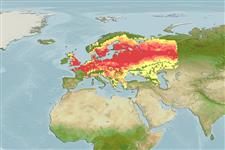分類 / Names
俗名 | 同種異名 | Catalog of Fishes (gen., sp.) | ITIS | CoL | WoRMS | Cloffa
Actinopterygii
輻鰭魚綱 (條鰭魚) >
Cypriniformes (Carps) >
Cyprinidae (Minnows or carps) > Cyprininae
Etymology: Carassius: Latinization of , karass, karausche, European crucian carp (Ref. 45335).
環境 / 氣候 / 範圍
生態學
; 淡水; 半鹹淡水 居於水底的; 河川洄游 (Ref. 51243); 深度上下限 5 - ? m (Ref. 2163). 2°C - 22°C (Ref. 1672), preferred ?; 69°N - 35°N, 10°W - 169°E
Eurasia: North, Baltic, White, Barents, Black and Caspian Sea basins; Aegean Sea basin only in Maritza drainage; eastward to Kolyma drainage (Siberia); westward to Rhine and eastern drainages of England. Absent from North Sea basin in Sweden and Norway. In Baltic basin north to about 66°N. Widely introduced to Italy, England and France but possibly often confused with Carassius gibelio (Ref. 59043). At least one country reports adverse ecological impact after introduction.
大小 / 重量 / 年齡
Maturity: Lm ? range ? - ? cm
Max length : 64.0 cm TL 雄魚/尚未辨別雌雄; (Ref. 6114); common length : 15.0 cm TL 雄魚/尚未辨別雌雄; (Ref. 556); 最大體重: 3.0 kg (Ref. 556); 最大年齡: 10 年 (Ref. 59043)
背棘 (總數): 3 - 4; 背的軟條 (總數): 13-22; 臀棘 2-3; 臀鰭軟條: 5 - 7; 脊椎骨: 32. Diagnosed from its congeners in Europe by having the following characters: body golden-green shining color; last simple anal and dorsal rays weakly serrated; 23-33 gill rakers; lateral line with 31-36 scales; free edge of dorsal convex; anal fin usually with 6½ branched rays; and peritoneum white (Ref. 59043). Caudal fin with 18-20 rays (Ref. 2196). No barbels. The third dorsal and anal-fin rays are strong and serrated posteriorly.
Adults occur in shallow ponds, lakes rich in vegetation and slow moving rivers. They burrow in mud in the dry season or during winter (Ref. 2163). Usually restricted to densely vegetated backwaters and oxbows of lowland rivers. Can survive at high temperatures and at very low oxygen concentrations during summer and under ice cover (Ref. 59043). Tolerates cold, organic pollutants, and low oxygen levels in the water (Ref. 30578). Feeds all day but mainly at night on plankton, benthic invertebrates, plant materials and detritus. Usually does not occur in waters with rich ichthyofauna and abundant predatory species, but very abundant in the absence of other fish species. Spawns in dense submerged vegetation (Ref. 59043). Marketed fresh and frozen; eaten fried, broiled and baked (Ref. 9988). Live up to about 10 years. There is a gradual but continuing extirpation in many water bodies, especially in Danube drainage and central Europe, possibly to due competition with introduced Carassius gibelio in non-optimal habitats (Ref. 59043).
Life cycle and mating behavior
成熟度 | 繁殖 | 產卵場 | 卵 | 孕卵數 | 仔魚
Females spawn multiple times during the spawning period (Ref. 88808). Reproduction in May-June in shallow water with dense vegetation, eggs 130000-250000/female adhere to plants, hatch after 4-8 days (Ref. 2163). Individual female spawn with several males. Males follow ripe females, often with much splashing. Eggs are sticky and are attached to water plants (Ref. 59043).
Kottelat, M. and J. Freyhof, 2007. Handbook of European freshwater fishes. Publications Kottelat, Cornol and Freyhof, Berlin. 646 pp. (Ref. 59043)
CITES (Ref. 94142)
Not Evaluated
人類使用
漁業: 高經濟性; 養殖: 商業性; 游釣魚種: 是的; 水族館: 商業性; 誘餌: occasionally
更多資訊
合作者照片Stamps, Coins聲音神經毒速度泳型鰓區Otoliths腦重體重比眼睛色素
工具
特別的報告
下載 XML
網路資源
